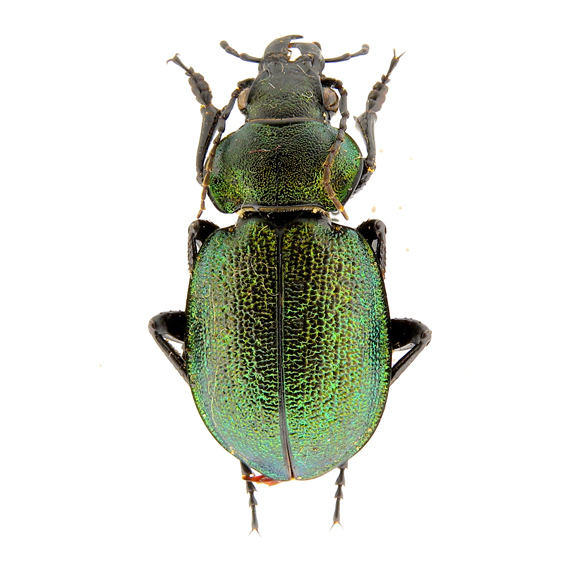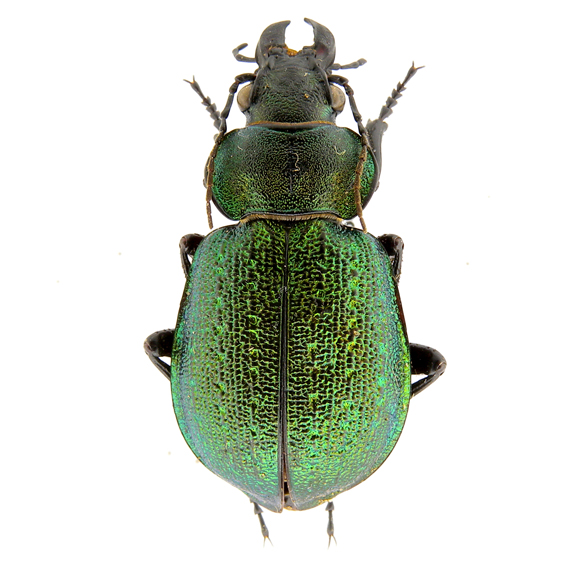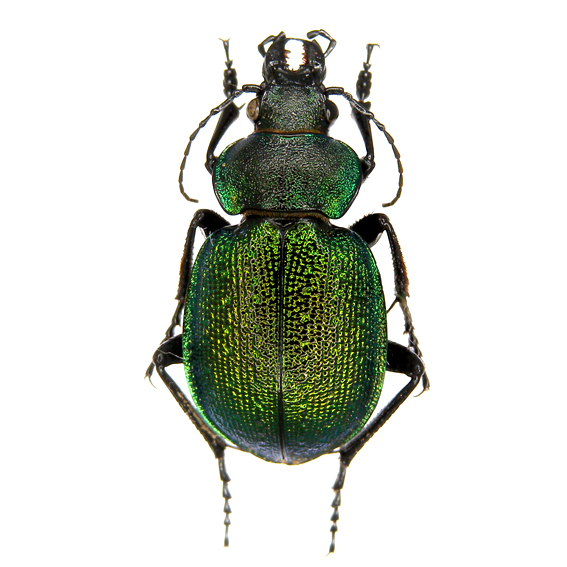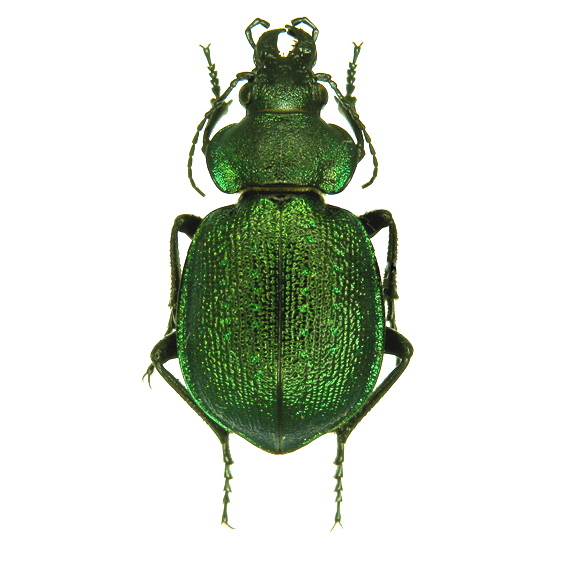Calosoma (Callisthenes) reticulatum (Fabricius, 1787)
Carabus reticulatus Fabricius, 1787: 197 (described from: Europa), lectotype in Natural History Museum of Denmark, Copenhagen
Calosoma reticulatum Weber, 1801: 20
Callisphaena reticulatum Motschulsky, 1859: 127
Calosoma (Callisthenes) reticulatum Jakobson, 1905: 257
Calosoma (Callisphaena) reticulatum Csiki, 1927: 29
Calosoma (Chrysostigma) reticulatum Breuning, 1928: 82
Callisthenes (Callisphaena) reticulata Lapouge, 1932: 373
Callisthenes (Callisphaena) reticulatus Jeannel, 1940: 184
Callisthenes (Callisphaena) reticulatus earinus Obydov & Putz, 1996: 521 (type locality: Kazakhstan, Zhana Arka); holotype ♂ in Zoological Museum of the Russian Academy of Sciences, Saint Petersburg
Calosoma (Callisthenes) reticulatum Gebert J., 2015: 203
Callisthenes reticulatus Turin & al., 2015: 252
Callisthenes reticulatus reticulatus Schmidt & Trautner, 2016: 38
Length 22-26 mm. C. reticulatum is distinguished by the presence of wings and the relatively small, transverse and regularly rounded pronotum.
It used to be widespread, but sporadic, in Northern Europe: from Belgium, Holland and Danmark through Austria Germany and Poland, up to Sweden and Baltic coast, but absent from Finland (Andersen et al., 2005: 14), contrary to the opinion of some previous authors (Obidov, 2002: 97; Löbl & Smetana, 2003: 118). The citations by Burgess & Collins (1917: 68) of Switzerland and France arise from a misunderstanding and should not be taken into consideration. We can add that, though Calosoma reticulatum is not now living in Britain, it can be identified from fossil evidence to have lived in the southern parts of these islands during a last-glacial warm stage (Coope, 1979).
At present, at least as regards the western part of the distributrion area and except for occasional individual findings, populations of C. reticulatum seem to survive in few restricted localities, less troubled by intensive use. In fact, according to the recent literature, we know the existence of the populations of Nederland and East Germany confined in derelict military training areas, now protected areas (Turin & al., 2015), and of the one of Öland island in southern Sweden, known and protected since long (Lundkvist & Fagerstrom, 2015). Towards East, C. reticulatum is found in Russia from the Baltic coast to western Siberia and in Kazakhstan. From these last regions, that correspond to the easternmost part of the distrubution area, has been described a slightly different population (reticulatus earinus Obydov & Putz, 1996), characterized by shorter, more convex, elytra.
There are some ancient citations from Ukraine (Jakobson, as reported in Breuning, 1928b: 97) and from Caucasus, all of them considered doubtful by Obidov (2002: 97). However, the presence of the species in North Caucasus, which was originally based on some vague indications, has been later confirmed as far as Daghestan is concerned and, therefore, North Caucasus represents the actual southern limit of the habitat of C. reticulatum.
Examined specimens and literature’s data
Austria. Burgenland: Purbach (SB), Nikelsdorf, Zurndorf (Mandl 1957: 106), Neusiedler lake (TL); Niederösterreich: Neuestadt (SB), Brück a. d. Leitha, Fischamend (Mandl 1957: 106), Leithagebirge (Breuning, 1928a: 83), Wismutinsel (Biologiezentrum Linz in www.gbif.org/); Oberösterreich: Linz env. (Mandl 1957: 106), between Mariahilf and Schullerberg (Dalla Torre, 1877: 18), Deutsch Jahrndorf (Schweiger, 1990: 148).
Belarus. Western Belarus (Alexandrovich & al., 1996); Grodno (Obidov, 2002: 97).
Belgium. Antwerp: Postel (Everts, 1903; Breuning, 1928a: 83); Masbourg (Turin & al. 2015: 254).
Czech Republic. Bohemia (NMP).
Denmark. South Jutland: Sønderjylland (Schiødte, 1841: 309); East Jutland: Vejle, Kolding (Lindroth & Bangsholt, 1985: 49).
Finland. (Obidov, 2002: 97).
Germany. Brandenburg: Berlin (Breuning, 1928a: 83), Oder-Spree distr. (Putz, 1995: 152), Lecshower Heide (http://molbiol.ru/), Brandenburg (EM), Pommern (EM, SB), Potsdam, Erkner (Obidov, 2002: 97); Seddin, Bad Wilsnack, Niedergörsdorf, Angermünde, Lienewitz, Spreewald (Löbbecke Museum Düsseldorf in www.gbif.org); Hesse: Frankfurt district (http://www.carabidae.ru); Mecklenburg: Jabel, Lenorenwald, Kalkhorst (Löbbecke Museum Düsseldorf in www.gbif.org), Drewitz, 10 km NNW Malchow (Dieckmann, 1967: 27); Sachsen-Anhalt: 5 km north-west Colbitz (Nicolai,1993: 49), Havelberg env. (Putz, 1995: 152); Thüringen: Sömmerda, Erfurt (Hartmann, 2007: 156).
Hungary. Vértes hegységben (Vértes Mountains), Csákvár (Csiki, 1906: 125), Mosonmagyaróvár (Csiki, 1944: 105).
Kazakhstan. Akmola: Astana (Tselinograd; sub reticulatus earinus, Obidov, 2002: 97); Aktobe: Embi env. (Emba; sub reticulatus earinus, SB); Atyrau: 20 km NW Usturt (Novoaleksandrovsk vill., Aktobe; sub reticulatus earinus, Obidov, 2002: 97); Karaganda: Kyzylzhar (sub reticulatus earinus, Obidov, 2002: 97); Ulytau: Zhanaarka (Zhana-Arka, Atasu; sub reticulatus earinus, Obidov, 2002: 97).
Netherlands. Gelderland prov: Harskamp env (Turin & al. 2015: 254); between Hoog Buurlo and Gerritsflesch (NBC RMNH.INS.670937); Den Haag (Breuning, 1928a: 83).
Poland. Baltic seashore; Szczecin; Pomeranian Lake District; Wieck env. Chojnice; Mazury Lake District; Lowlands of Wielkopolska-Kujawska; Chodzież; Lower Silesia; West Prussia; Western Sudetes Jedlina-Zdroj env. Wałbrzych (http://baza.biomap.pl/); Gdansk (Obidov, 2002: 97), Miastko, Przęsin (Löbbecke Museum Düsseldorf in www.gbif.org).
Russia. Bashkortostan: Davlekanovo (www.inaturalist.org); Orenburg (Breuning, 1928b: 92; Obidov, 2002: 97, sub reticulatus earinus); Tjumen: Tobol'sk (Jeannel, 1940: 184, questioned by Obidov, 2002: 97); Kalinigrad: Primorsk (Russkoe env) (Alekseev, 2008: 158); Riaz (Rjazan), Moscow, Brjansk, Smolensk, Tula, Kirov (Orlov), Kaluga (www.carabidae.org); Caucasus (TL); Daghestan: Gumbetovskyi dist: Mekhelta 1600m. (SB), Dokuzparinsky dist: Kurush (Kryzhanovskij & al. 1995: 34); North Ossetia-Alania (IZIKO in www.gbif.org/).
Slovakia. Prašice (= Nyitraperjes) (Csiki, 1944: 105).
Sweden. Skǻne (Breuning, 1928a: 83); Bohuslän: Foss, Torreby (Lindroth & Bangsholt, 1985: 49); Öland: Stora Alvaret (http://www.natureeyes.dk/), Ottenby (http://www.pbase.com/), Hulterstad (www.inaturalist.org).
Ukraine. (quotes questioned by Obidov, 2002: 96) Podolia (Breuning, 1928b: 97); Cherson (Breuning, 1928b: 97)
Notes: Winged, but its actual ability to fly is doubtfull (Gebert, 2015: 208; Turin & al., 2015: 257; Schmidt & Trautner, 2016: 39). It is diurnal as well as nocturnal, and adults can be captured in pit traps. It is a xerophylus species and a ground dweller. In the past it was collected in a variety of habitats as sandy grasslands, sparse forest of pines, cultivated fields. At present, at least with respect Northern Europe, it is restricted to Calluna heath lands.
Based on the examined specimens, adults are active mostly in May-June and they remain so up to July-August (Gebert, 2015: 205). According to Burmeister (1939: 28) oviposition takes place in the same period with an average of 60 to 70 eggs. The development up to the adult stage takes about two months and the beetle overwinters in its hatching cell. The new generation will appear from the end of April to early May. The adult can then still overwinter and remain active for two or three years (Dieckmann, 1967: 27).
The larval stages were described and figured by Burgess & Collins (1917: 71), who studied the biology of the species and that tried, between 1908 and 1910, its acclimatization in Massachusetts, but without success.
 (Fabricius, 1787) Germany, Pommern, ex coll. Reitter |
 (Fabricius, 1787) Germany, Pommern, ex coll. Reitter |
 (Fabricius, 1787) Kazakhistan: Aktjubinsk reg., Emba env., 5.V.2014 sub Callisthenes (Callisphaena) reticulatus earinus |
 (Fabricius, 1787) Kazakhistan: Aktjubinsk reg., Emba env., 5.V.2014 sub Callisthenes (Callisphaena) reticulatus earinus |